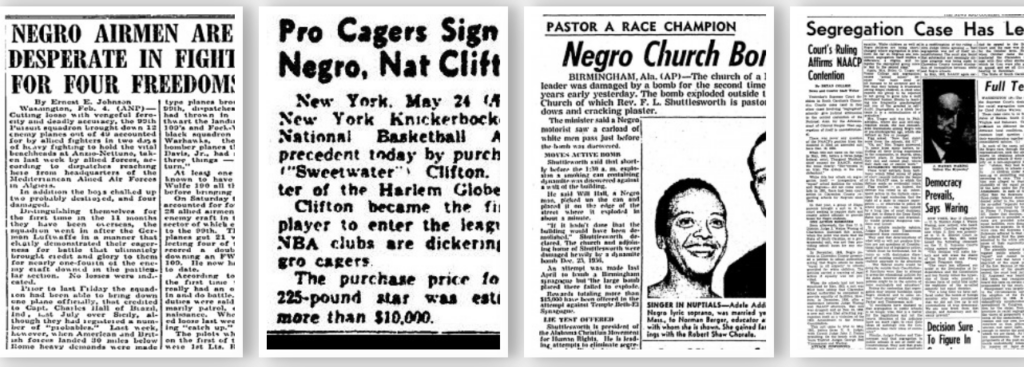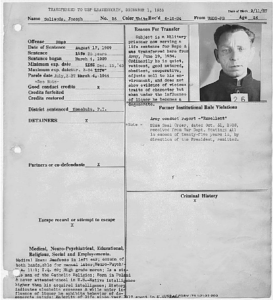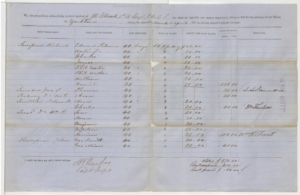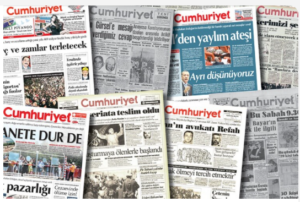Author: dorner
TRIAL: Mass Observation Project

Until April 28, 2022, the Library has trial access to the Mass Observation Project. Launched in 1981 by the University of Sussex as a rebirth of the original 1937 Mass Observation, its founders’ aim was to document the social history of Britain by recruiting volunteers to write about their lives and opinions. Still growing, it is one of the most important sources available for qualitative social data in the UK.
The Mass Observation Project consists of directives (questionnaires) sent out by the Project and the responses gathered. They address topics such as the Falklands War, clothing, attitudes to the USA, reading and television habits, morality and religion, and Britain’s relations with Europe. Broad themes covered include current events, friends and family, the home, leisure, politics, society, culture and the media, work, finance and the economy and new technology.
EVENT: Getting your book published open access: a panel discussion with Springer Nature and UC Berkeley
Are you a scholarly author interested in publishing a book, but unfamiliar with how to find an editor or press? Have you considered publishing that book open access and want to understand your open access book publishing options?
Springer Nature and UC Berkeley invite you to join us for a virtual panel discussion.
Hear from a panel of Springer Nature Open Access Books Editors in both STM and the Humanities, and a recent author about the process of getting your manuscript published.
You’ll come away from this discussion with practical advice about opportunities at UC Berkeley to publish open access books with Springer Nature, and guidance for submitting and revising your work, writing a book proposal, approaching editors, signing your first contract, and navigating the peer review and publication process.
While the event is focused on supporting UC Berkeley authors, it is open to all, as other institutions may be interested in entering into open access book agreements with publishers.
When: Monday, 14th March 2022; 11am-12:15pm PDT
Where: https://us06web.zoom.us/webinar/register/WN_VhjMRxIhQ3CmhYuPDv0nGw
RSVP: Please click on the link above to register and you’ll receive a Zoom link to join on the day.
— — — — —
Just FYI, here are a few of the UCB authored/edited books made available OA through the agreement so far. There are several more in the works.
- Natasha Distiller – Complicities: A theory for subjectivity in the psychological humanities
- Jean Walrand – Probability in Electrical Engineering and Computer Science
- Joan DeJaeghere, Erin Murphy-Graham – Life Skills Education for Youth
Trial: Black Life in America
Until March 15, the Library has trial access to Black Life in America, This resource consists of two parts: BLA (1704-1877): Arrival in America Through Reconstruction and BLA (1878-1975): Jim Crow Through Civil Rights. Both series are comprised of articles from over 20,000 mostly American, but some international newspapers about all manner of Black life in America.

Primary Sources: Digitized records recently added to the NARA catalog
 The National Archives and Records Administration recently added new sets of records of digitized items to its catalog.
The National Archives and Records Administration recently added new sets of records of digitized items to its catalog.
Warden’s Notebook Pages, 1934 – 1963 (Alcatraz)
These looseleaf notebook pages contain basic summary information about, and an identification photograph (frontal view of face), of each inmate. In some cases collateral material, such as disciplinary reports or news clippings, are also included. Some of the information in these records is incorrect when compared with the more extensive inmate files. Several warden’s notebook pages are not extant, although accompanying disciplinary reports filed with the notebook page are sometimes available. The records were also microfilmed in 1978 by the Bureau of Prisons. The microfilmed version includes some/all of the “missing” original pages. These pages have been printed and interfiled among the original records. The records may be restricted due to privacy concerns. Register numbers 1 through 900 have been screened and are open for research.
Boulder Canyon Project Histories, 1948 – 1966
This series contains histories, which include photographs, data tables, maps, and technical drawings, that describe projects authorized under the Boulder Canyon Project Act, namely Boulder Dam (later renamed Hoover Dam), Boulder Power Plant, located on the Colorado River, and the All-American Canal, all Bureau of Reclamation projects. The histories include information on project construction, operation, and maintenance, including the installation of power plant machinery. The records document the creation and construction of Boulder City, Nevada, and Lake Mead National Recreation Area.
Photographs Relating to Federal Aviation Facilities, 1946 – 1972
This series consists of photographs relating to the Federal Aviation Administration’s area operations and facilities throughout Alaska. These locations and facilities include the Aleskya Oil Pipeline, Mt. McKinley or Denali, Merrill Field, Elmendorf Air Force Base, Akiak, Amchitka, Cordova, Fairbanks, Iliamna, Kodiak, Metlakatla, Nenana, Nome, Portage, Skagway, Juneau, Tanana, and Wrangel.
Information Cards for Inmates of the Langenstein-Zwieberge Concentration Camp, ca. 1947 – ca. 1947
This series consists an index to inmates of the Langenstein-Zwieberge concentration camp. Each index file includes the inmate’s name, date of birth, nationality, and prisoner number. Files of deceased inmates are marked with a cross. The index, originally created by the German authorities in charge of the camp, is in German.
Intelligence Files, 1946 – 1953
The Intelligence Files include charts, graphs, correspondence, memorandums, reports, and printed materials and is comprised of four subseries. The Central Intelligence Files subseries consists mostly of daily summaries of the military situation in Korea from June 1950 to January 1953, with references to political and economic issues, cease-fire negotiations, and communist propaganda. Also in the subseries are intelligence memorandums concerning Europe, the Truman Doctrine, the Marshall Plan, Israel, Yugoslavia, and China.
Event: Workshops on working with qualitative and textual data
The Library Data Services Program is offering a series of workshops on working with qualitative and textual data. Each workshop is designed to help novice learners get started with cleaning, organizing, analyzing, and presenting qualitative or textual data. Sessions include cleaning and coding qualitative data in MaxQDA and the open-source Taguette program, organizing and writing up research projects in Scrivener, and archiving qualitative data once a project has been completed. Each workshop is designed to act as a starting point for learning concepts and will familiarize attendees with additional resources for getting help.
Wednesday, January 26th from 10:00 – 11:00 AM
Tuesday, February 15th: 10:00 AM – 12:00 PM
Monday, March 14th: 1:00 – 3:00 PM
Monday, April 18th: 1:00 – 3:00 PM
Workshop: Introduction to Zotero via Zoom
 An Introduction to Zotero workshop will be offered at three different times on two days this month.
An Introduction to Zotero workshop will be offered at three different times on two days this month.
Thursday, February 3 at 10 AM, noon, and 4PM
Wednesday, March 9 at 10 AM, noon, and 4PM
Spend an hour and learn how to use this robust citation manager. The workshop covers importing citations, exporting bibliographies into Word and Google Docs, and sharing resources among groups.
Register at the Library’s workshop page. If you have a chance, download the program and browser connector from Zotero.org before the workshop.
You may also be interested in this tutorial created by one of my colleagues, Margaret Phillips. It also walks you through the basics, using short instructional videos.
Primary Sources: Hispanic American Newspapers, 1808-1980

The Library has acquired Readex’s Hispanic American Newspapers, 1808-1980, a collection of Spanish- and English-language newspapers printed in the U.S. during the 19th and 20th centuries. The papers are sourced from the “Recovering the U.S. Hispanic Literary Heritage Project,” a national research effort directed by Nicolás Kanellos, Brown Foundation Professor of Hispanic Studies at the University of Houston.
The resource can be cross-searched with other Readex historical newspaper series, including Early American Newspapers, Caribbean Newspapers, and African American Newspapers, 1827-1998.
Primary Sources: Confederate Slave Payrolls
 The National Archives recently released a digitized collection of Confederate Slave Payrolls, 1861-1865 that are part of Record Group 109, War Department Collection of Confederate Records. The records list the names and locations of the slaves whose labor was leased to the Confederacy for a variety of tasks, including digging entrenchments, creating obstructions on rivers, digging potassium nitrate for gunpowder, and providing labor at ordnance factories and arsenals. The payrolls provide the name and usually the place of residence of each slave owner. The information provided about the slave included his or her name, date and place employed, occupation, number of days worked, daily rate of pay, total amount of pay, and name of the Confederate Officer responsible for the payroll. The article “Civil War Confederate Slave Payroll Records” provides more information about the content and organization of the records.
The National Archives recently released a digitized collection of Confederate Slave Payrolls, 1861-1865 that are part of Record Group 109, War Department Collection of Confederate Records. The records list the names and locations of the slaves whose labor was leased to the Confederacy for a variety of tasks, including digging entrenchments, creating obstructions on rivers, digging potassium nitrate for gunpowder, and providing labor at ordnance factories and arsenals. The payrolls provide the name and usually the place of residence of each slave owner. The information provided about the slave included his or her name, date and place employed, occupation, number of days worked, daily rate of pay, total amount of pay, and name of the Confederate Officer responsible for the payroll. The article “Civil War Confederate Slave Payroll Records” provides more information about the content and organization of the records.
Primary Sources: Cumhuriyet Digital Archive
 The Library recently acquired the Cumhuriyet Digital Archive, which provides access to the complete run of the newspaper since its establishment in 1924. This information is provided on the digital platform: “…Cumhuriyet (“The Republic”) is the oldest secular Turkish daily newspaper and is widely considered one of the last remaining opposition newspapers in Turkey. Founded by journalist Yunus Nadi Abalıoğlu at the initiative of Mustafa Kemal Atatürk, Cumhuriyet was the first newspaper of the Turkish Republic and promoted a belief in democracy, secularism and the rule of law. According to the newspaper’s editorial principles: Cumhuriyet is an independent newspaper; it is the defender of nothing but the Republic, of democracy in the scientific and broad sense. It will fight every force that tries to overthrow the Republic and the notion and principles of democracy. It will endeavor for the embracing by society of the principle of secularism along the path of “Enlightenment” ushered in by Atatürk’s revolution and principles.”
The Library recently acquired the Cumhuriyet Digital Archive, which provides access to the complete run of the newspaper since its establishment in 1924. This information is provided on the digital platform: “…Cumhuriyet (“The Republic”) is the oldest secular Turkish daily newspaper and is widely considered one of the last remaining opposition newspapers in Turkey. Founded by journalist Yunus Nadi Abalıoğlu at the initiative of Mustafa Kemal Atatürk, Cumhuriyet was the first newspaper of the Turkish Republic and promoted a belief in democracy, secularism and the rule of law. According to the newspaper’s editorial principles: Cumhuriyet is an independent newspaper; it is the defender of nothing but the Republic, of democracy in the scientific and broad sense. It will fight every force that tries to overthrow the Republic and the notion and principles of democracy. It will endeavor for the embracing by society of the principle of secularism along the path of “Enlightenment” ushered in by Atatürk’s revolution and principles.”
Primary Sources: Cuban Periodicals: Cultural Magazines Published by Casa de las Américas, 1960–2009
